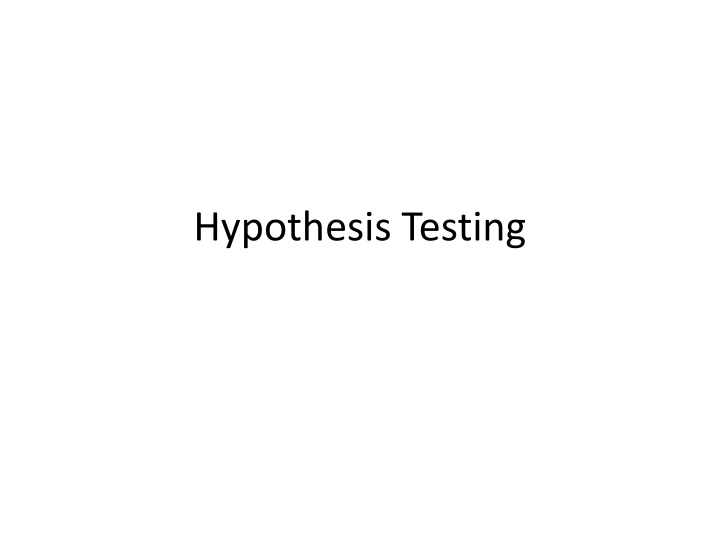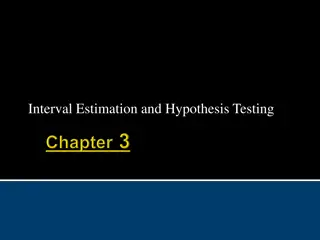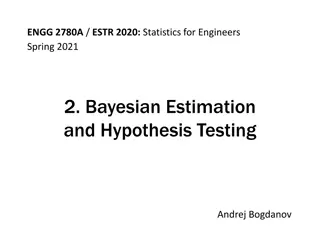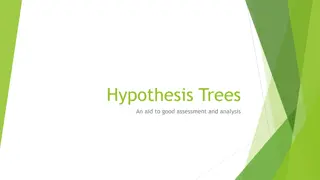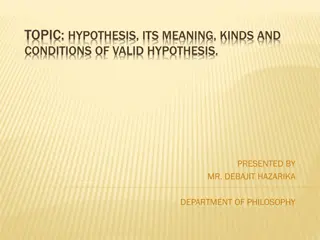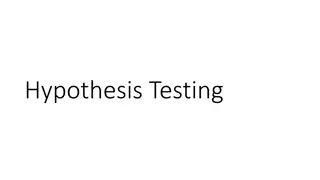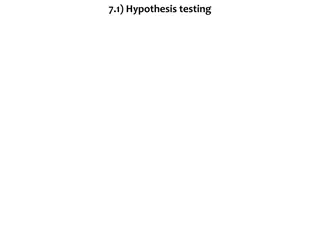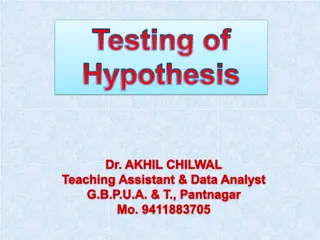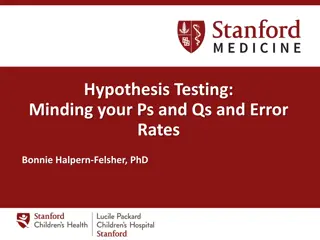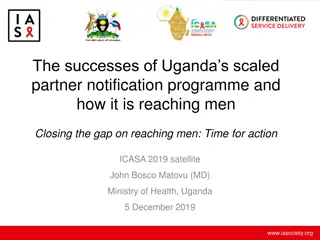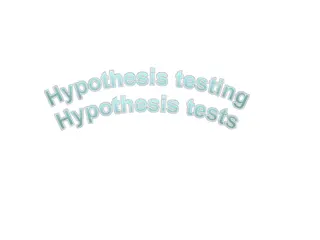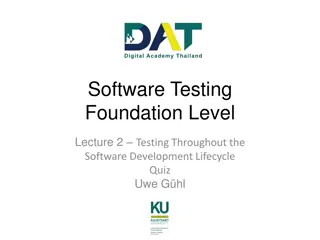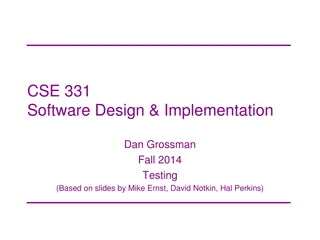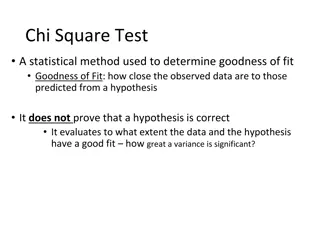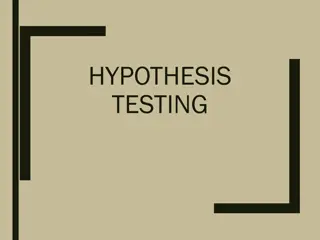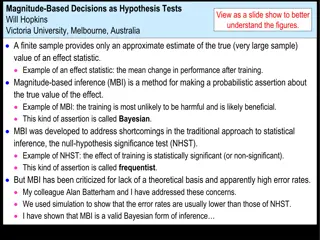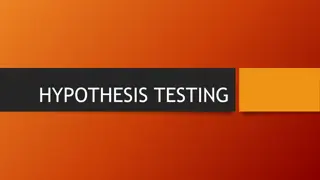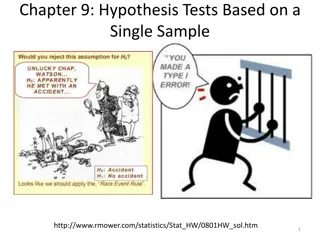Hypothesis Testing
Hypothesis testing is a crucial aspect of statistical analysis, where hypotheses are formulated, tested, and conclusions are drawn regarding parameters. This process involves setting null and alternate hypotheses, determining p-values and significance levels, and understanding Type I and Type II errors in decision-making. Illustrated with examples such as free throws and the death penalty, this content explains the concepts of hypothesis testing in a clear and engaging manner.
Download Presentation

Please find below an Image/Link to download the presentation.
The content on the website is provided AS IS for your information and personal use only. It may not be sold, licensed, or shared on other websites without obtaining consent from the author.If you encounter any issues during the download, it is possible that the publisher has removed the file from their server.
You are allowed to download the files provided on this website for personal or commercial use, subject to the condition that they are used lawfully. All files are the property of their respective owners.
The content on the website is provided AS IS for your information and personal use only. It may not be sold, licensed, or shared on other websites without obtaining consent from the author.
E N D
Presentation Transcript
1 of 10 I m awesome at free-throws I make 80% of my basketball free throws. Ok, fine I ll prove it. I go and do 100 free throws. I make 78 free throws!
Hypotheses(always in terms of parameter) Null hypothesis (H0) Conservative. Assume existing claim. A weird difference or lie isn t there. Example: H0: p=0.80, I make free throws 80% of the time. Assumed to be true, unless the sample data is different enough than expected. If this happens, H0 is rejected for the alternate hypothesis (HA) Examples: HA: p < 0.80, I make free throws less than 80% of the time. HA: p 0.80, I don t make free throws 80% of the time. HA: p > 0.80, I make free throws more than 80% of the time. 2 of 10
3 of 10 P-value, alpha, and Significance P-value The probability, assuming H0 is true, that your observed sample statistic would take a value as or more extreme Smaller P = more evidence against H0 Alpha ( ), also called level of significance Pre-determined decision point. If your P-value goes past this, your results are significant , and you reject H0 in favor of HA. Results are significant when P < . Example: The results were significant at P<0.01 .
Ho is actually true Ho is actually false TYPE I ERROR ( alpha) Bad! Awesome! (power) Something weird is going on, & you figured it out. Nothing weird is going on, but you say Hey everybody, there s something weird! You reject Ho Boring, but correct. TYPE II ERROR ( beta) Bad! You fail to reject Ho You didn t find anything, and that s ok because there s nothing to find. Something weird is going on, & you missed it.
5 of 10 Example The Death Penalty You re a jury member for a case of 1st-degree murder. If the defendant is found guilty, the sentence is death. H0: The defendant is not guilty. HA: The defendant is guilty. Ho is actually true TYPE I ERROR ( alpha) The defendant is not guilty, but you sentence him to death. Ho is actually false Awesome! (power) The defendant is guilty, and you sentence him to death. You reject Ho Correct. The defendant is not guilty, and you find him not guilty. TYPE II ERROR ( beta) The defendant is guilty, but he escapes justice. You fail to reject Ho
6 of 10 Calculating Error H0: Suspect is innocent. HA: Suspect is guilty. 1. What is the probability of a Type I Error? 2. What is the probability of a Type II Error? 3. What is the power? TRUTH Innocent Guilty Jury s Decision Innocent 131 15 Guilty 9 125
Example, one-sample mean z-test In a 1993 study, researchers took a sample of 40 people who claimed to have had an intense experience with a UFO, and tested their IQ (Spanos et al., 1993). The national average IQ is known to be normally distributed with = 100 and = 15. If the mean IQ of the 40 people in the study was 95.5, does this provide convincing evidence (at =0.05) that UFO sighters have different IQ s? 1. H0: = 100, HA: 100, where = mean IQ. One-sample mean z-test. 2. Independence: We assume that there are more than 400 (10n) UFO sighters . Normality: Stated. Random: Not met. Not stated. 5 . 95 = = n 7 of 10 100 statistic parameter = 9 . 1 z 15 3. 40 Two-tailed: Double P-value! ) 9 . 1 0287 . 0 = 0574 . 0 = ( 2 P z 4. This result is not significant at the =0.05 level since P>0.05. I fail to reject H0. There is not evidence that UFO sighters have different IQ s.
8 of 10 Example, two-sample mean t-test In the last year, I have had 68 AP Statistics students. I removed one female outlier, and the remaining data were Normally distributed. Among the 43 females, the average GPA was 3.75, with s=0.432. Among the 23 males, the average GPA was 3.60, with s=0.47. Do female AP Statistics students have higher GPA s than male AP Statistics students, at =0.05? 1. H0: F M = 0, HA: F M > 0, where = mean weighted GPA for female and male students, respectively. This is a two-sample mean t-test. 2. Independence: We assume there are more than 430 (10n) female and 230 male AP Statistics students. Normality: stated. Random: not met. 3. . 0 + n n . 3 ( 75 . 3 60 ) 0 statistic parameter = = . 1 = 27 t 2 2 2 2 432 . 0 47 + P . 0 10 . 0 15 43 23 4. Assuming randomness, this result is not statistically significant at the =0.05 level since 0.10<P<0.15. I fail to reject H0. Female AP Statistics students do not have higher GPA s than male AP Statistics students.
A 60 59 69 86 82 62 75 77 61 70 87 67 66 65 70 70 50 100 63 82 77 78 61 74 74 62 61 80 69 78 45 58 63 73 46 77 73 58 F Example, paired-difference mean t-test Yesterday I gave you either a red F or a blue A and asked you to count your heart beats for 60 seconds. Do students in the F group have higher pulse rates than students in the A group. n Mean s A group 19 65.8947 10.9347 11.2343 F group 19 71.2632 8.447 8.6785 H0: 1 - 2 = 0 HA: 1 - 2 < 0 who have either a blue A or a red F . This is a paired-difference mean t-test. 1 - 2 is the difference between the pulse rates of students Independence is met, it s assumed that the population of negative and positive students is greater than 190 each. Normality is met, the data sets are both approximately linear on a quantile plot. Randomness is not met. 78
10 of 10 Special-case 2-sample proportion A study that evaluated the effects of a reduction in exposure to traffic- related air pollutants compared respiratory symptoms of 283 residents of an area with congested streets with 165 residents in a similar area where the congestion was removed because a bypass was constructed. For the residents of the congested streets, 17 reported that symptoms of wheezing improved during the year, while 35 of the residents of the bypass streets reported improvement. Is there significant evidence ( =0.05) that the residents of the congested streets had less improvement than those of the bypass streets? . 0 ( 06 . 0 212 ) 0 = = . 4 85 z 1 1 + 116 (. )( 1 116 . ) 283 165
